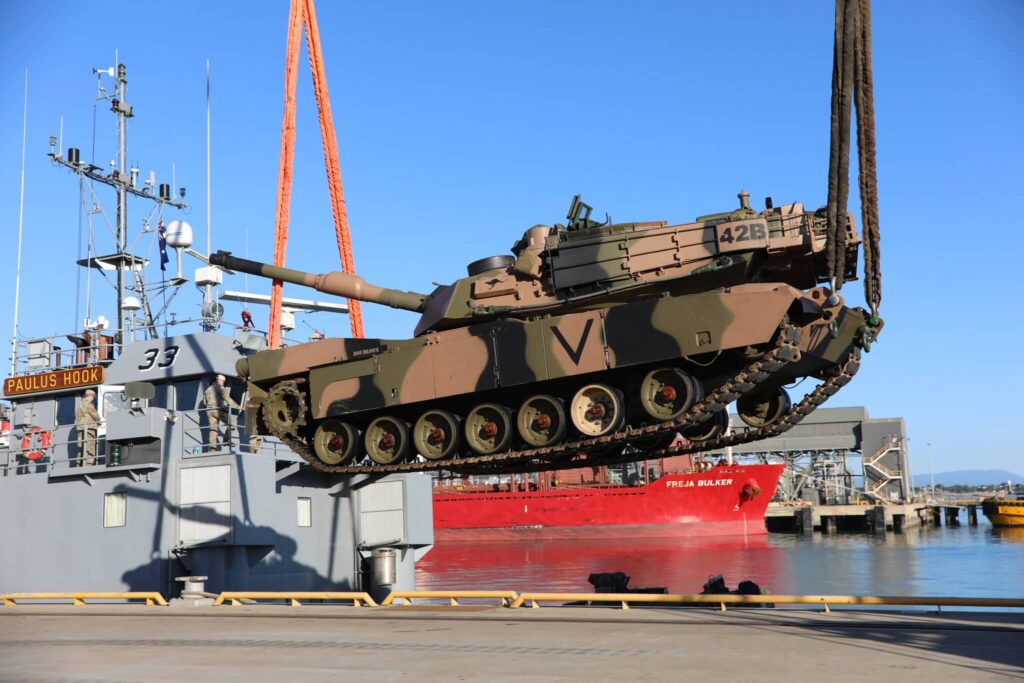
Australia’s military ambitions to enhance its ship-to-shore capabilities are facing significant hurdles, as evidenced during the recent Exercise Talisman Sabre 2025. The exercise, held from July 13 to 27, highlighted the Australian Army’s reliance on outdated amphibious assets amid delays in the delivery of new landing craft.
The capability gap became apparent when the US Army’s landing craft utility (LCU), USAV Paulus Hook, was deployed to transport military vehicles during the exercise. On July 19, the vessel loaded four M1A2 SEPv3 Abrams tanks and an M88A2 armored recovery vehicle at the port of Townsville, Queensland, for transport to Gladstone. This was one of 800 activities during Talisman Sabre 2025, involving multiple nations in amphibious operations.
Long Voyage and Strategic Deployment
The USAV Paulus Hook’s journey from Yokohama, Japan, to Australia took 22 days, underscoring the logistical challenges faced by the Australian military. The craft, part of the US Army’s 5th Transportation Company, is designed for coastal operations and can land vehicles on beaches. However, during the exercise, the vehicles were loaded using a crane, nearing the vessel’s 318-tonne payload capacity.
Warrant Officer 1 Chad Arness, master of the USAV Paulus Hook, highlighted the strategic importance of deploying such assets in the Indo-Pacific region. “Our company, the first CWC unit deployed outside the USA, operates five such landing craft,” he noted. The US Army’s forward deployment strategy also includes positioning landing craft in Australia.
Australia’s Amphibious Capability Gaps
The Australian Army and Royal Australian Navy (RAN) currently lack vessels comparable to the Runnymede-class LCUs. The army’s aging LCM-8 landing craft, dating back to the Vietnam War, are incapable of carrying tanks. Although the LCM-1E landing craft attached to the RAN’s Canberra-class landing helicopter docks can carry M1A1 Abrams tanks, the newer M1A2 SEPv3 Abrams are heavier, necessitating further qualifications.
Australia’s plans to introduce new landing craft classes under Project Land 8710 have encountered delays. Phase 1A aims to deliver 18 Landing Craft Medium (LCM), while Phase 2 involves eight Landing Craft Heavy (LCH). Lieutenant General Simon Stuart, Chief of Army, stated, “Our plan is to have the first medium in the water by the end of 2026, the first heavy by the end of 2028.” However, contract signing delays threaten these timelines.
“They’re about to go into preliminary design review with an immature design and lots of risk,” an industry source told the ABC, indicating potential delays of up to two years.
Strategic Importance and Learning Opportunities
The amphibious requirements are crucial for Australia’s defense strategy in the Indo-Pacific region. Lieutenant Eugene Lynch emphasized the importance of rehearsing amphibious movements, stating, “Our focus is on the Indo-Pacific region, and our near region is characterized by archipelagos and the littoral environment.”
Despite the delays, Talisman Sabre 2025 provided the Australian Army an opportunity to observe and learn from the US military’s use of medium landing craft. Australian soldiers have been training in the US and will participate in the Orient Shield exercise in Japan, gaining valuable experience.
“We’re excited to be down here for Talisman Sabre 25 testing our capabilities as a new company, and obviously sharing the knowledge and working in conjunction with our partners,” said Arness.
Looking Ahead
The exercise serves as a preview of what the Australian Army aims to achieve in the future, despite the uncertainty surrounding the timeline. The delays in acquiring new landing craft underscore the challenges in modernizing the military’s amphibious capabilities. As Australia seeks to enhance its strategic presence in the region, the successful execution of Project Land 8710 remains critical.
The ongoing collaboration with international partners and the lessons learned during Talisman Sabre 2025 will be pivotal in bridging the current capability gaps and ensuring the Australian military is equipped to meet future challenges.







